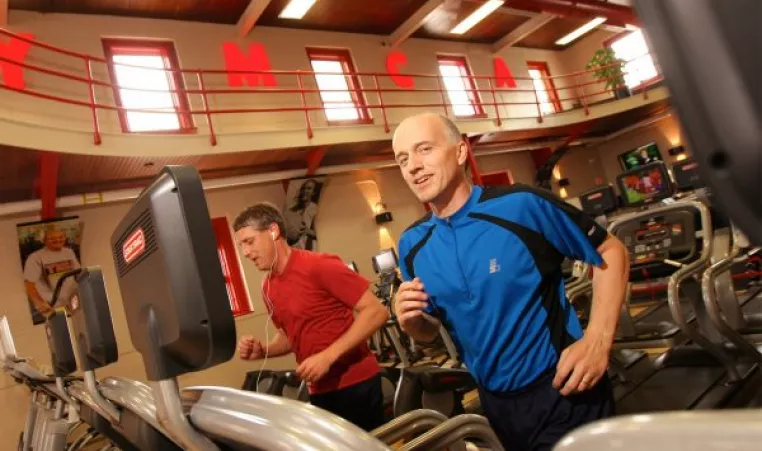
MEN LOOKING TO RESTART AN EXERCISE REGIMEN SHOULD DO SO GRADUALLY
Source: RBJ.net
First, it might be a good idea to detour to your physician’s office, particularly if you haven’t undergone a medical examination in awhile and you’re getting on in years.
“You want to make sure that you check in with the physician to make sure that your heart is healthy enough, your lungs are healthy enough to actually undergo the stress and demands of the exercise program,” says Sandeep Mannava M.D., an orthopaedic surgeon at UR Medicine who treats sports injuries.
Tests for diabetes, hypertension and other conditions might also be warranted. You don’t want to learn that you suffer from one of them while on the weight bench or squash court.
“If they have high blood pressure, arthritis, those types of conditions, you’re just setting yourself up for an event that could happen,” says Laura Fasano, vice president for healthy living of the YMCA of Greater Rochester.
Such conditions might not prevent you from exercising, but could lead you to exercise differently than planned. The right kinds of activities can reduce the effects of coronary artery disease or strengthen an arthritic joint.
“Light to moderate exercise in order to maintain motion within those joints is quite helpful in treating that arthritis,” Mannava explains. “Strengthening the muscles around a particular joint that has arthritis takes some of the stress off those arthritic surfaces.”
At the same time, you need to tailor the exercise of an arthritic joint to the limits imposed by the disease.
“If there was more arthritis behind, say, the kneecap, or the patellofemoral portion of the joint, we would have a patient like that avoid deep squats,” Mannava explains.
Coupled with a healthy diet, the right exercise regimen can also help you lose weight, reducing stress on your heart and joints. Your physician can advise you regarding the exercises to do, and what you should avoid.
Once you get to the gym, you might make use of one of the professional trainers and coaches on staff. Dave Hamill of Planet Fitness regularly helps his customers design their exercise programs.
“We’ll discuss all the things that come into play when picking out or putting together the perfect workout regimen for you,” the fitness trainer explains. “Whether it’s health reasons, your physical appearance, if you suffer from an injury—all those things come into play.”
When you do start working up a sweat, keep in mind that—well, you’re a guy.
“Men, especially, tend to…jump into it either too quickly or too intensely,” Hamill says.
Overdoing it right out of the gate can cause unnecessary aches and pains, and even physical damage.
“Jumping back into something you’ve been away from for awhile can cause kind of overuse-type injuries, such as strains and sprains,” Mannava explains.
Instead, go slowly in the beginning.
“Your first couple of weeks in should be almost what I call a ‘warning shot’ to your body, letting your body know this is what we’re doing now,” Hamill says.
Love the clank of weights? Start light and get your form down before boosting the poundage.
“Focus upon not how much we’re lifting, but how well we’re lifting it,” Hamill explains. “We could make 10 pounds…feel like 100 pounds, as long as we’re lifting it correctly.”
That can be tougher when sports are your preferred form of exercise.
“That’s not necessarily a structured environment,” Fasano explains. “You’re going to go back out, you haven’t talked to anybody and you’re going to play full court.”
However you choose to exercise, you can gain more from the activity by warming up. Hamill recommends that you engage in cardiovascular exercise—which can involve spending time on a treadmill, elliptical trainer or other machine—and stretching.
“A light stretch before, and maybe a little more of an intense stretch afterwards, is going to help you not be as sore the next day,” Hamill says. “It’s going to help with flexibility; it’s going to help with endurance.”
For Mannava, how you warm up depends upon the activity involved and your needs.
“Warming up is performing that particular activity, or some cardiovascular exercise, at a sub-maximal effort,” he says.
OK, you’re warmed up. What kinds of exercises should you do? You might take a walk or run, spend time on a cross-training machine or other device, or engage in any other type of activity that benefits the cardiovascular system.
“Anything that elevates your heart rate and that you can sustain, that’s ongoing and continuous, and uses large muscle groups,” Fasano says.
While you’re boosting your heart rate, you’re also burning calories. Do these types of exercises for 20 to 60 minutes at a stretch.
You would also do well to include strength training in your exercise regimen.
“It is extremely important for men, and for everyone, to have a component of strength training specifically in your core region to be able to maintain posture and alignment for everyday activity,” Fasano explains.
Essentially, your core region is just about everything but your arms and legs. You can strengthen that region’s muscles in the weight room, by doing pushups, sit-ups and the like, or by other means.
As you grow more buff—or at least try to—take steps to increase the flexibility of your muscles. Inactivity and age reduces their elasticity, making them more prone to tears, aches and pains.
“We typically know men are weak in their flexibility in their lower back and their hamstrings,” Fasano explains.
While traditional stretching can improve muscle flexibility, some men are taking Pilates or yoga classes at the Y in order to become suppler, according to Fasano.
In the final analysis, any kind of exercise can be beneficial to your body if you do it regularly.
“It’s important that people stick with what they enjoy doing,” Mannava says. “If they enjoy doing it, they’re going to maintain that kind of healthy lifestyle, and get the best benefits from exercise.”
Whatever exercises you choose to do, pay attention to your body. A pain that won’t go away after several days could result from a torn ligament, which would require medical treatment. Left-side chest pain, nausea and other symptoms of a heart attack demand immediate action—get to a doctor fast.
We guys like to think of ourselves as invulnerable, but we only get one body.
Mike Costanza is a Rochester-area freelance writer.
